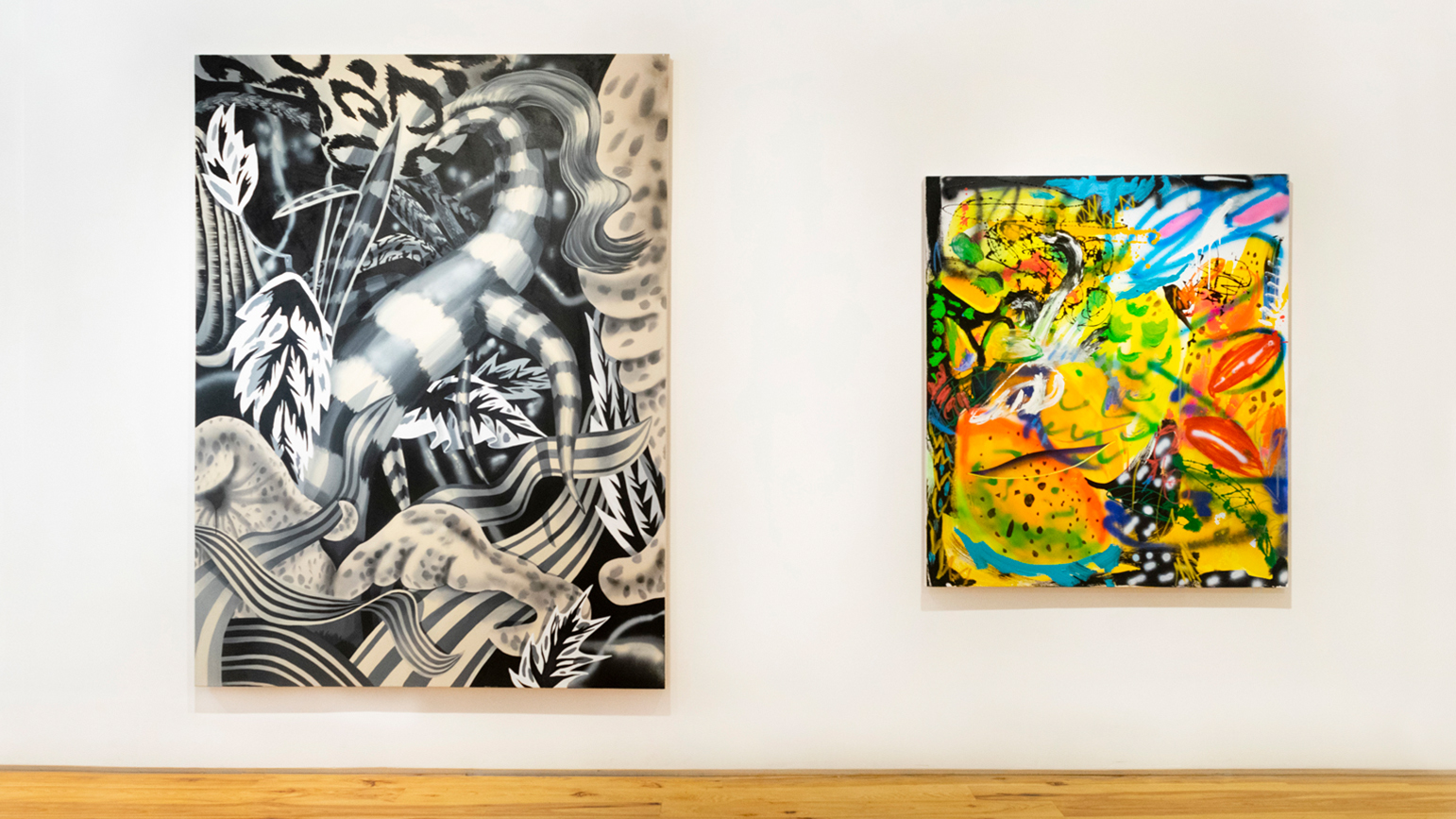
“Surface Tension,” a solo exhibition of Professor Natalie Westbrook’s new body of work, is on view at Freight+Volume’s new Tribeca location May 21 to July 10th.
Westbrook’s paintings hinge on a craftsmanlike ambiguity. However bold, colorful, or allusive her paintings appear, they always conceal something about their origins and ends. This sense of ‘in-betweenness’—a crepuscular realm, both brilliant and obscure—liberates her work from the plague of binaries that too often overtakes artists and their work. It also makes her connection to art history as freewheeling as her application of color across each canvas.
Throughout her current exhibition, “Surface Tension,” Westbrook is engaging in what might be called serious play. There’s always an element of detachment in her work, which doesn’t preclude consummate emotional investment in any single painting. Simultaneously, there’s also the aegis of formalism—borrowed from design as much as resources inherent in the history of painting—which allows her work to boil over like an alchemical experiment. This latter ‘experimental’ quality contributes to that air of detachment, of objectively registering the internal relationship between disparate pictorial elements.
John Cage famously defined ‘experimental’ as an action for which ‘the outcome … is not foreseen.’ For Westbrook, I like to think, her outcomes are not so unforeseen to herself. Her allusions to elements of graphic design (to name only one thing) belie this. But as a pictorial gestalt, the directions she takes her work are almost certainly unknown to the viewer. In a single painting, there can be a labyrinth of aspects which tease out one impression, while giving way to another entirely. A painting like ‘Ripen,’ for instance, is marvelously balanced while alluding to myriad approaches to lineation and form. On one plane, there’s the lips. They seem inspired by graphic design, reminiscent of a cartoon visage on a child’s trapper keeper. But Westbrook owns them in their fire-apple redness. In the same painting, on an entirely separate plane, she makes allusion to gestural painting and graffiti. That all these elements should be resolved in a single canvas, which flirts with maximalism with the utmost tastefulness, is nothing short of terrific. Yet all this blooming, buzzing confusion, these textures and visual noise, can just as well reduce itself to a grid of vertical and horizontal lines, like a maelstrom drawn against Cartesian coordinates.
This is what makes Westbrook’s works so rewarding. While not deceiving the viewer, they bring together opposing elements, generating a fluorescent spark that flies across the canvas like a tapestry of girandoles. Melding a kind of garish Neue Wilde sense of color to mathematical rigorousness is only one accoutrement Westbrook carries in her arsenal of tricks.
Insofar as a thread of surreality runs through “Surface Tension,” one would do well to recall the inspiration Comte de Lautréamont provided the early French Surrealists: ‘…as beautiful as the chance meeting on a dissecting-table of a sewing-machine and an umbrella.’ This random association of two functionally unequal objects, in a spatial context that (linguistically, at least) seems to be splitting itself apart, is duly echoed in Westbrook’s more figurative paintings.
In another work dating from just this year, ‘Lumen,’ a clay-like figure seems to recline in an otherworldly Mar-a-Lago. Floating leopard prints and vegetation, grouped together in this gray-scale tableaux, seem as little related to each other as the disparate objects de Lautréamont referenced. And yet the painting doesn’t end here. The folds in the reclining figure’s belly, the pinstripe planes that resemble roads, weave a surreptitious narrative that can only be classified as mysterious—however many interpretations the viewer might read into the work. In its orchestration of elements, ‘Lumen’ is both concrete and abstract, open-ended and thoroughly finalized.
All of which leads us back to the exhibition’s title: “Surface Tension.” While Westbrook’s surfaces give way to prospects that sometimes allude to the materiality of paint and pigment, and, at other times (sometimes within the same canvas) to more illusionistic modes of representation, one often feels that some surreptitious source material is implied. A totem of heads; snow panther patterns; lipsticked mouths adrift in cyclonic space—however dissimilar these elements might seem, the surface of the canvas allows for them to be brought into relationship with one another.
Such is the pleasure of Westbrook’s experimental modality. Her paintings confront the limits of what painting makes possible. By saying this, I don’t mean to suggest that her paintings readily conform to some postmodern archetype (although they do allude to this, on occasion), but that they personalize how art history can become assimilated into the workings of an individual artist. For all her experimentation and detachment, Westbrook’s heart is laid bare in these works. Her surfaces are less surrealist inventions, than the mindful discoveries of a flâneur who notes a certain slant of light scintillating against a florist’s window display, offset by police sirens tolling a lysergic knell.
A limited edition catalogue accompanying the show features essays by Jeffrey Grunthaner and Christian Hendricks.




